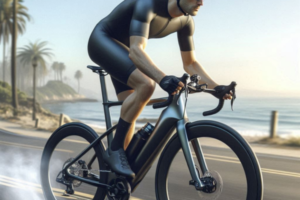🧵 Why Clothing Matters in Aerodynamic Performance
When we think about improving the performance of an electric bicycle, we often focus on the machine itself — motor efficiency, battery life, tire resistance, or frame geometry. Yet, one of the most overlooked components is the clothing worn by the cyclist. In reality, clothing plays a significant role in overall aerodynamic drag, which can directly affect speed, battery consumption, and rider stability — especially in humid environments where airflow becomes denser and sweat management becomes a necessity.
According to studies in sport aerodynamics, up to 80% of the total drag force experienced by a cyclist comes from the rider’s body. This means that no matter how streamlined the bicycle is, loose, flapping, or poorly ventilated garments can quickly erase those gains. As electric bikes become more common in urban and coastal settings, where wind and moisture are everyday companions, optimizing what riders wear is becoming an essential part of aerodynamic strategy.
In humid climates, additional challenges arise. Moisture in the air thickens the airflow, increasing resistance. At the same time, the body’s thermoregulation struggles, leading to more sweat and discomfort. Clothing must not only reduce drag, but also promote airflow, wick moisture effectively, and maintain comfort over long rides. Finding this balance between aerodynamics and breathability is the key to smart apparel design for e-bike riders in these conditions.
👕 How Fabric Type Influences Drag and Comfort
Not all fabrics behave the same in motion. Traditional cotton, while breathable, becomes heavy when wet and clings to the skin, increasing friction and restricting movement. On the other hand, synthetic technical fabrics — such as polyester blends, elastane, or nylon with hydrophobic properties — are specifically engineered to reduce surface tension and maintain a tight profile even when damp.
Modern cycling apparel often incorporates textured surfaces similar to a golf ball’s dimples, designed to delay airflow separation and reduce drag. These fabrics aren’t just tight — they’re smart. When used in key zones like the shoulders, chest, and upper arms, they help the body cut through humid air more efficiently. Meanwhile, mesh panels or laser-cut vents placed in sweat-prone areas promote ventilation without billowing or flapping.
Additionally, fabric weight and flexibility matter. Lightweight, stretchable materials reduce bunching and allow the garment to conform to the rider’s body at all times. This minimizes micro-turbulence — small pockets of disturbed air that build up around folds and seams — which, over long distances, add up to considerable aerodynamic loss.
✂️ Seam Placement and Garment Construction
The way a cycling jersey or jacket is cut and sewn also plays a key role in its aerodynamic performance. Flatlock seams, raglan sleeves, and minimal panel overlaps help reduce disruption to airflow. In humid conditions, where even small amounts of drag feel exaggerated due to heavier air and stickier skin, these details matter even more.
Strategic seam placement can also support posture and reduce fatigue. For instance, garments designed with a riding-forward posture in mind will include curved panels on the back and sides, reducing pressure points and maintaining a close fit when the rider leans into the wind. This ergonomic tailoring doesn’t just improve comfort — it ensures consistent aerodynamic efficiency throughout the ride.
💨 Wind Tunnel Testing for Apparel
One of the most effective ways to evaluate cycling apparel is through wind tunnel testing — a practice long used in professional cycling, but now increasingly adopted by performance-focused commuter and e-bike clothing brands. These controlled environments allow engineers and designers to visualize how garments behave at various speeds and humidity levels, pinpointing where drag occurs and how fabric movement influences airflow.
In humid climates, these tests become even more insightful. As air density increases with moisture content, even minor imperfections in garment fit or structure can have a magnified impact. A sleeve that slightly flutters at 25 km/h in dry air may cause disruptive turbulence at the same speed in a coastal environment. Wind tunnel tests simulate these real-world conditions, allowing developers to fine-tune their designs for consistent aerodynamic performance, regardless of weather.
In many cases, results show that tighter isn’t always better. Overly restrictive garments can distort posture or restrict natural movement, which can ironically increase drag by forcing the rider into a less aerodynamic shape. The best clothing designs offer a balance — they are snug without being tight, and they stretch strategically without losing shape or airflow control.
🌡️ Temperature Regulation and Breathability
Humid climates create unique challenges for temperature regulation. Sweat doesn’t evaporate as quickly, and excess heat becomes trapped between the skin and the garment. To combat this, high-performance cycling clothing uses moisture-wicking technology, venting zones, and breathable materials that work together to keep the rider dry and cool — while still maintaining a streamlined profile.
For example, some jerseys integrate micro-perforated fabric in low-wind zones like the underarms or lower back. This allows for heat escape without disrupting frontal aerodynamics. Others use ultrathin mesh that lies flush against the skin, channeling sweat outward through capillary action and allowing quick drying, even during long commutes or uphill climbs.
Many apparel companies are also exploring sustainable, breathable materials such as bamboo-derived fabrics or recycled polyester with cooling finishes. These not only reduce the environmental impact of manufacturing but also offer lighter weight and better ventilation in tropical or coastal environments.
Ultimately, good cycling clothing for humid conditions isn’t just about staying dry — it’s about helping the rider maintain a consistent body temperature. When core temperature rises, the body expends more energy trying to cool itself, which reduces performance and increases fatigue. Well-designed garments support the body’s natural cooling systems, indirectly improving aerodynamic efficiency by keeping the rider comfortable and focused.
🎽 The Role of Base Layers and Layering Strategy
Another critical but often misunderstood aspect of clothing aerodynamics is layering. In humid environments, layering must strike a careful balance between ventilation and cling. Technical base layers — thin, stretchy garments worn directly on the skin — play a vital role in sweat management and garment stabilization.
Base layers absorb moisture quickly and transfer it to the outer garment, keeping the skin drier and more comfortable. They also prevent jerseys from shifting or ballooning in the wind, especially on longer rides. Far from adding bulk, the right base layer enhances the fit of the outer layer and contributes to a smoother aerodynamic silhouette.
🧳 Accessories and Their Aerodynamic Impact
While most attention in cycling clothing focuses on jerseys, shorts, and jackets, accessories can have a surprisingly strong influence on aerodynamics — especially in humid, windy environments. Items like backpacks, panniers, rain capes, and even helmets with visors can add significant drag if not carefully chosen or positioned.
In coastal cities where many riders carry items like laptops, groceries, or water bottles, large bags are common. Unfortunately, a boxy backpack disrupts airflow across the shoulders and upper back, creating a “wake” of turbulence that increases resistance and reduces efficiency. Wind tunnel simulations have shown that a rider with a standard rectangular backpack can experience up to 12% more aerodynamic drag compared to one with a tapered, low-profile commuter pack.
Similarly, rain ponchos or capes — popular in humid regions where surprise showers are common — often billow while riding, catching the wind and acting like a sail. Modern alternatives now use magnetic closures or leg straps to keep the fabric close to the body, reducing flapping and maintaining a smoother airflow profile.
Helmets also deserve mention. A well-ventilated helmet is essential in hot and humid climates, but it should be designed to balance airflow with aerodynamic flow. Streamlined commuter helmets with internal air channels can offer cooling without creating unnecessary drag. Helmets with visors or mounted lights should be tested to ensure they don’t create protrusions that catch the wind during head movement.
🌬️ Clothing Adjustments for Wind Conditions
Another key insight from aerodynamic clothing design is the importance of adaptability. Since wind conditions vary throughout the day — especially near coastal zones — having garments that adjust to those changes can be a smart strategy for daily commuters.
Many brands now offer convertible jackets with zip-off sleeves, or vests with packable backs that can be stored during calm segments and worn during gustier stretches. These garments are designed to remain sleek and tight-fitting in all modes, ensuring minimal disruption to airflow regardless of how they’re worn.
Some riders carry lightweight wind shells that can be layered over a jersey on downhill or exposed sections, then removed once the headwind passes. These pieces are made from high-stretch, breathable materials that cling to the rider’s body and provide a clean, aerodynamic silhouette — even in motion.
📏 Custom Fit vs. Universal Sizing
While many cyclists purchase off-the-rack apparel, there’s growing interest in semi-custom or adaptive fit clothing, especially among those who ride in challenging climates. Garments designed with multiple body types in mind — using elastic panelling, adjustable hems, and articulated seams — offer a closer, more aerodynamic fit for a wider range of riders.
For those who ride regularly, investing in performance apparel with a tailored fit can result in noticeable improvements in speed and comfort. Some companies now offer scanning or virtual fitting tools that allow customers to select the best size and cut for their riding posture and climate — combining function, fit, and style into a single aerodynamic advantage.
🚲 Real-World Benefits of Aerodynamic Clothing in Humid Climates
Many cyclists are surprised to learn how much of a difference well-designed clothing can make — not just in races, but in everyday commuting. For riders in humid, windy, or coastal regions, the benefits of aerodynamic apparel extend beyond mere speed. They touch on energy conservation, ride comfort, and even safety.
In a case study conducted in Cartagena, Colombia, a group of urban e-bike commuters tested standard cotton T-shirts versus fitted technical jerseys over a series of daily rides. On average, riders wearing aerodynamic jerseys consumed 8–10% less battery on the same routes — a clear indicator that clothing choices were reducing drag and helping the motor work more efficiently.
In another informal trial in Miami, Florida, commuters reported improved handling when switching from loose, casual wear to performance apparel. Crosswinds were less disruptive, and the improved breathability reduced fatigue during peak humidity hours. Even without scientific equipment, riders noticed they arrived at destinations feeling less drained and more in control.
These real-world examples reinforce what simulations and wind tunnels show: clothing matters, especially when the air is thick, warm, and moving fast. And for electric bike users — whose machines are already doing part of the work — every gain in efficiency translates into longer rides, fewer charges, and a more enjoyable experience overall.
🌐 Sustainability and Ethical Design
As the demand for performance-oriented cycling gear grows, many riders are also paying attention to how their clothing is made. Fortunately, aerodynamic clothing and sustainability are no longer mutually exclusive. Brands are increasingly turning to recycled fibers, water-efficient dyeing techniques, and local manufacturing to reduce environmental impact without sacrificing function.
Some companies now offer performance jerseys made from ocean-recycled plastics, which are both breathable and fast-drying — ideal for humid climates. Others invest in biodegradable packaging, fair labor practices, and modular production cycles that reduce waste. When riders choose these garments, they not only improve their ride but also contribute to a more responsible cycling culture.
In regions where climate change is already impacting humidity, rainfall, and wind patterns, these choices matter. Aerodynamic clothing that lasts longer, performs better, and is made ethically becomes a valuable part of sustainable urban mobility. It’s a reminder that performance and conscience can coexist — beautifully.
📦 Packing Smart for Variable Weather
In humid regions, weather can shift quickly — from sun to wind to rain — in just a few kilometers. This makes smart clothing packing an important part of every ride. Aerodynamic garments are now designed to pack down into small pockets or pouches, so riders can layer up or down without adding bulk or drag.
Some performance jackets fold into their own rear pocket and can be strapped under the saddle or inside a small frame bag. Lightweight arm warmers, packable vests, and breathable gaiters give cyclists the flexibility to adapt to changing conditions while maintaining a clean aerodynamic profile throughout the journey.
🧭 Choosing the Right Garments: A Practical Guide for Riders
For cyclists navigating humid and windy environments, choosing the right clothing isn’t just about aesthetics — it’s a strategic decision. Whether you’re a commuter, a long-distance explorer, or a recreational weekend rider, the clothing you wear shapes your experience on the bike in more ways than one.
Here’s a quick checklist to help guide your aerodynamic clothing choices in humid climates:
- Fit over fashion: Opt for garments with a snug, tailored fit that support your natural riding posture.
- Moisture-wicking fabrics: Prioritize technical materials that draw sweat away from the body and dry quickly.
- Ventilation zones: Look for laser-cut vents, mesh panels, or dual-layer designs that allow heat to escape without flapping.
- Minimal seams: Seamless or flatlock-stitched designs help reduce drag and skin irritation during long rides.
- Lightweight layering: Choose packable wind shells and convertible jackets that offer flexibility without compromising aerodynamics.
- Consider accessories: Use low-profile helmets, compressive base layers, and streamlined bags or racks when needed.
Riders who adopt these practices often report feeling faster, more comfortable, and more in tune with their ride — not because they’ve changed their bikes, but because they’ve changed how they move through the air. Clothing becomes not just a garment, but a performance tool.
💬 Final Thoughts
In the world of electric and urban cycling, the importance of aerodynamic design is growing — and clothing is no exception. Especially in humid climates, where airflow and body temperature become more difficult to manage, the garments a cyclist wears can make the difference between a ride that feels effortless and one that feels like a battle against the wind.
By choosing intelligently designed apparel that fits well, breathes easily, and cuts through the air, riders improve not only their speed and energy efficiency, but also their confidence, comfort, and long-term sustainability. And in doing so, they become part of a movement that values both performance and conscious design.
Have you noticed how your clothing affects your ride? Whether you’ve faced a headwind with a flapping jacket or felt the comfort of a cooling jersey on a humid afternoon, your experience matters. Share your tips, questions, or favorite gear in the comments — let’s build a community where style meets science and every ride feels smoother.



